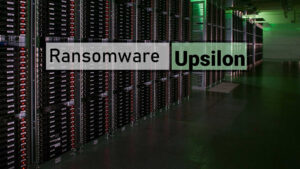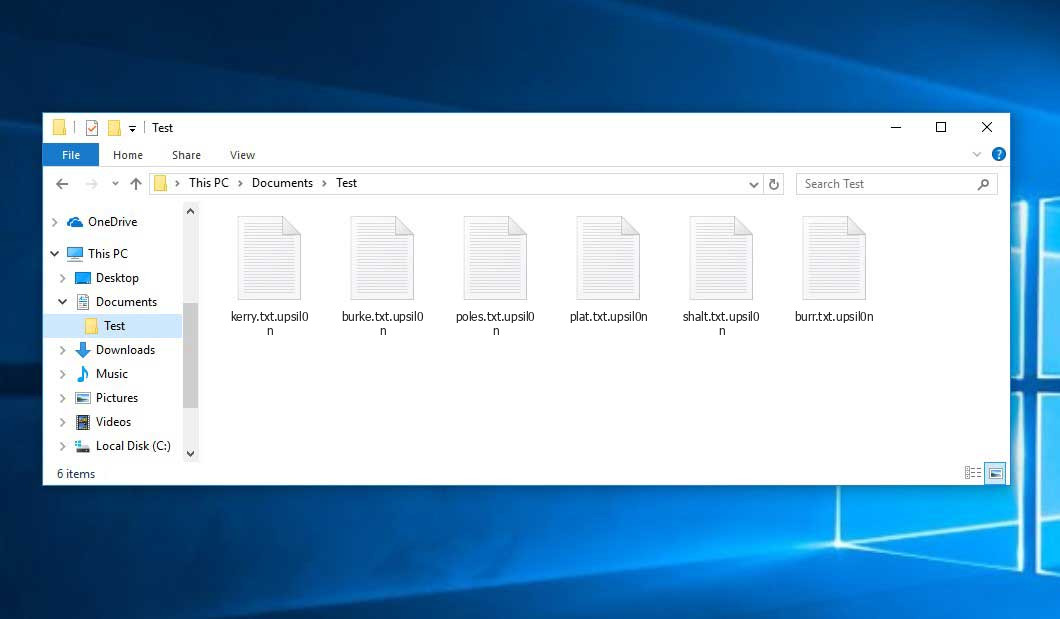The Upsilon virus belongs with the ransomware type of infection. Malware of such sort encrypts all the data on your computer (photos, text files, excel sheets, music, videos, etc) and appends its own extension to every file, leaving the Upsilon.txt text files in every directory containing encrypted files.
What is Upsilon virus?
☝️ A strictly accurate designation for the Upsilon is “a ransomware-type infection”.
Upsilon will add its own .upsil0n extension to the title of every encrypted file. For instance, a file named “photo.jpg” will be turned into “photo.jpg.upsil0n”. Just like the Excel table with the name “table.xlsx” will be changed to “table.xlsx.upsil0n”, and so forth.
In each folder that contains the encrypted files, a Upsilon.txt file will be created. It is a ransom money memo. It contains information about the ways of paying the ransom and some other information. The ransom note most probably contains instructions on how to buy the decryption tool from the ransomware developers. That is it.
Upsilon overview:
| Name | Upsilon Virus |
| Extension | .upsil0n |
| Ransomware note | Upsilon.txt |
| Detection | Crytex.Virus.FileInfector.DDS, Win32/Filecoder.OLC, Malware-Cryptor.InstallCore.5 |
| Symptoms | Your files (photos, videos, documents) have a .upsil0n extension and you can’t open them. |
| Fix Tool | See If Your System Has Been Affected by Upsilon virus |
In the screenshot below, you can see what a folder with files encrypted by the Upsilon looks like. Each filename has the “.upsil0n” extension added to it.
How did Upsilon ransomware end up on my PC?
There is a huge number of possible ways of ransomware injection.
Nowadays, there are three most popular ways for criminals to have the Upsilon virus settled in your system. These are email spam, Trojan infiltration and peer-to-peer file transfer.
If you open your mailbox and see emails that look like familiar notifications from utility services companies, delivery agencies like FedEx, web-access providers, and whatnot, but whose sender is unknown to you, beware of opening those emails. They are most likely to have a ransomware file enclosed in them. So it is even riskier to open any attachments that come with emails like these.
Another option for ransom hunters is a Trojan virus scheme1. A Trojan is an object that infiltrates into your PC disguised as something different. For instance, you download an installer for some program you need or an update for some software. But what is unpacked reveals itself a harmful program that encrypts your data. Since the installation file can have any title and any icon, you have to make sure that you can trust the resource of the files you’re downloading. The optimal thing is to trust the software companies’ official websites.
As for the peer-to-peer file transfer protocols like torrent trackers or eMule, the threat is that they are even more trust-based than the rest of the Internet. You can never guess what you download until you get it. So you’d better be using trustworthy resources. Also, it is a good idea to scan the directory containing the downloaded items with the antivirus as soon as the downloading is complete.
How to remove the Upsilon virus?
It is crucial to note that besides encrypting your data, the Upsilon virus will most likely deploy the Azorult Spyware on your machine to get access to credentials to different accounts (including cryptocurrency wallets). That program can extract your credentials from your browser’s auto-filling cardfile.
Sometimes tamperers would unblock some of your files so you know that they indeed have the decryption program. As Upsilon virus is a relatively new ransomware, anti-malware designers have not yet found a method to reverse its work. However, the decryption tools are constantly upgraded, so the effective countermeasure may soon be available.
Sure thing, if the evildoers succeed in encoding victim’s critical files, the hopeless person will most likely comply with their demands. Nevertheless, paying to racketeers does not necessarily mean that you’re getting your data back. It is still risky. After obtaining the money, the racketeers may deliver a wrong decryption key to the victim. There were reports about ransomware developers simply disappearing after getting the ransom without even writing back.
The best solution against ransomware is to have a system restore point or the copies of your essential files in the cloud disk or at least on an external storage. Surely, that might be not enough. The most important thing could be that file you were working upon when it all started. Nevertheless, it is something. It is also wise to scan your PC for viruses with the antivirus program after the system is rolled back.
There are other ransomware products, besides Upsilon, that work similarly. Examples of those are Maos, Isal, Znto, and some others. The two basic differences between them and the Upsilon are the ransom amount and the encoding method. The rest is almost identical: documents become encoded, their extensions altered, ransom notes are created in each directory containing encrypted files.
Some fortunate victims were able to decode the arrested files with the help of the free software provided by anti-malware specialists. Sometimes the hackers accidentally send the decryption key to the victims in the ransom note. Such an extraordinary fail allows the user to restore the files. But of course, one should never rely on such a chance. Make no mistake, ransomware is a tamperers’ technology to lay their hands on the money of their victims.
How сan I avert ransomware injection?
Upsilon ransomware has no superpower, so as any similar malware.
You can protect your system from ransomware attack in several easy steps:
- Never open any emails from unknown mailboxes with strange addresses, or with content that has nothing to do with something you are expecting (can you win in a money prize draw without even taking part in it?). In case the email subject is more or less something you are expecting, scrutinize all elements of the dubious email with caution. A hoax letter will always have a mistake.
- Avoid using cracked or untrusted programs. Trojan viruses are often spreaded as a part of cracked software, most likely under the guise of “patch” preventing the license check. Understandably, potentially dangerous programs are difficult to distinguish from trustworthy software, as trojans sometimes have the functionality you seek. Try to find information about this program on the anti-malware forums, but the optimal way is not to use such programs at all.
- And finally, to be sure about the safety of the objects you downloaded, check them with GridinSoft Anti-Malware. This software will be a powerful shield for your system.
Reasons why I would recommend GridinSoft2
There is no better way to recognize, remove and prevent ransomware than to use an anti-malware software from GridinSoft3.
Download Removal Tool.
You can download GridinSoft Anti-Malware by clicking the button below:
Run the setup file.
When setup file has finished downloading, double-click on the setup-antimalware-fix.exe file to install GridinSoft Anti-Malware on your PC.

An User Account Control asking you about to allow GridinSoft Anti-Malware to make changes to your device. So, you should click “Yes” to continue with the installation.

Press “Install” button.

Once installed, Anti-Malware will automatically run.

Wait for the Anti-Malware scan to complete.
GridinSoft Anti-Malware will automatically start scanning your PC for Upsilon infections and other malicious programs. This process can take a 20-30 minutes, so I suggest you periodically check on the status of the scan process.

Click on “Clean Now”.
When the scan has finished, you will see the list of infections that GridinSoft Anti-Malware has detected. To remove them click on the “Clean Now” button in right corner.

Frequently Asked Questions
🤔 How can I open “.upsil0n” files?Are the “.upsil0n” files accessible?
There’s no way to do it, unless the files “.upsil0n” files are decrypted.
🤔 The encrypted files are very important to me. How can I decrypt them quickly?
Hopefully, you have made a copy of those important files. In case you haven’t, there is still a chance that you do have a Restore Point from some time ago to roll back the whole system to the moment when it had no virus yet, but already had your files. The rest of the methods require patience.
🤔 If GridinSoft deletes the Upsilon malware, will it also delete my files that were encrypted?
No way! Unlike the ransomware program itself, the encrypted files do not jeopardize your system.
GridinSoft Anti-Malware only deals with actual threats. The malware that has infiltrated your computer is probably still active and it scans your system every so often to arrest any new files you might create on your PC after the initial attack. As it has been mentioned above, the Upsilon ransomware comes with the company. It installs backdoors and keyloggers that can take your account passwords by trespass and provide malefactors with easy access to your PC in the future.
🤔 What actions should I take if the Upsilon malware has blocked my PC and I can’t get the activation key.
If that happened, you need to prepare a flash memory card with a pre-installed Trojan Killer. Use Safe Mode to execute the procedure. You see, the ransomware runs automatically as the system launches and encrypts any new files created or brought into your machine. To stop this process – use Safe Mode, which allows only the vital applications to run upon system start. Consider reading our manual on running Windows in Safe Mode.
🤔 What could help the situation right now?
Some of the encrypted data can be found elsewhere.
- If you sent or received your important files through email, you could still download them from your online mail server.
- You may have shared photographs or videos with your friends or relatives. Just ask them to post those images back to you.
- If you have initially got any of your files from the Web, you can try downloading them again.
- Your messengers, social networks pages, and cloud storage might have all those files too.
- Maybe you still have the needed files on your old PC, a laptop, cellphone, memory stick, etc.
USEFUL TIP: You can use file recovery utilities4 to retrieve your lost information since ransomware encrypts the copies of your files, deleting the original ones. In the tutorial below, you can see how to use PhotoRec for such a recovery, but be advised: you can do it only after you remove the ransomware itself with an antivirus program.
Also, you can contact the following official fraud and scam sites to report this attack:
- In the United States: On Guard Online;
- In Canada: Canadian Anti-Fraud Centre;
- In the United Kingdom: Action Fraud;
- In Australia: SCAMwatch;
- In New Zealand: Consumer Affairs Scams;
- In France: Agence nationale de la sécurité des systèmes d’information;
- In Germany: Bundesamt für Sicherheit in der Informationstechnik;
- In Ireland: An Garda Síochána;
To report the attack, you can contact local executive boards. For instance, if you live in USA, you can have a talk with FBI Local field office, IC3 or Secret Service.
I need your help to share this article.
It is your turn to help other people. I have written this guide to help people like you. You can use the buttons below to share this on your favorite social media Facebook, Twitter, or Reddit.
Brendan SmithHow to Remove UPSILON Ransomware & Recover PC

Name: UPSILON Virus
Description: UPSILON Virus is a ransomware-type infections. This virus encrypts important personal files (video, photos, documents). The encrypted files can be tracked by a specific .upsil0n extension. So, you can't use them at all.
Operating System: Windows
Application Category: Virus
User Review
( votes)References
- You can read more on Trojans, their use and types in the Trojan-dedicated section of GridinSoft official website.
- GridinSoft Anti-Malware Review from HowToFix site: https://howtofix.guide/gridinsoft-anti-malware/
- More information about GridinSoft products: https://gridinsoft.com/comparison
- Here are Best Data Recovery Software Of 2023.


